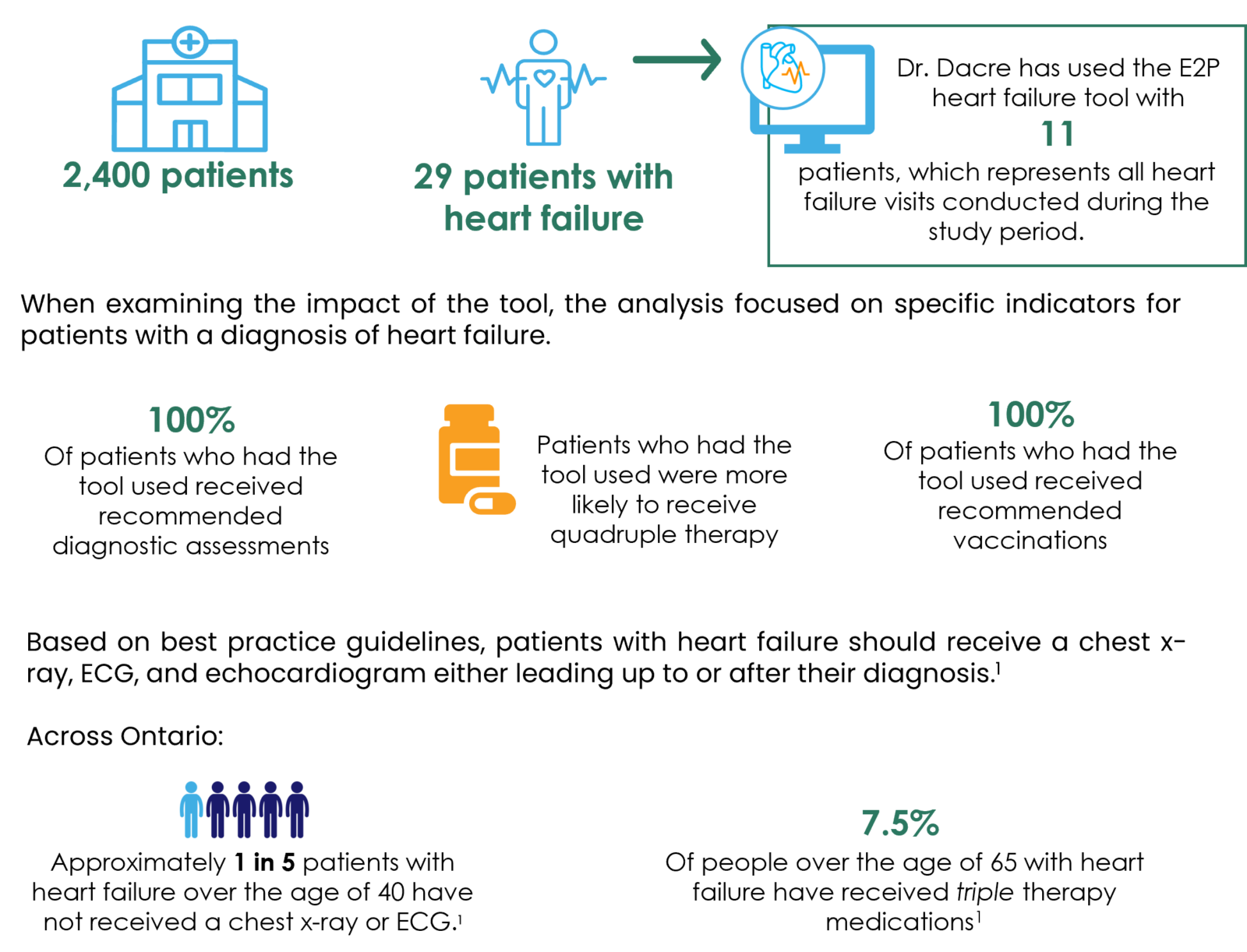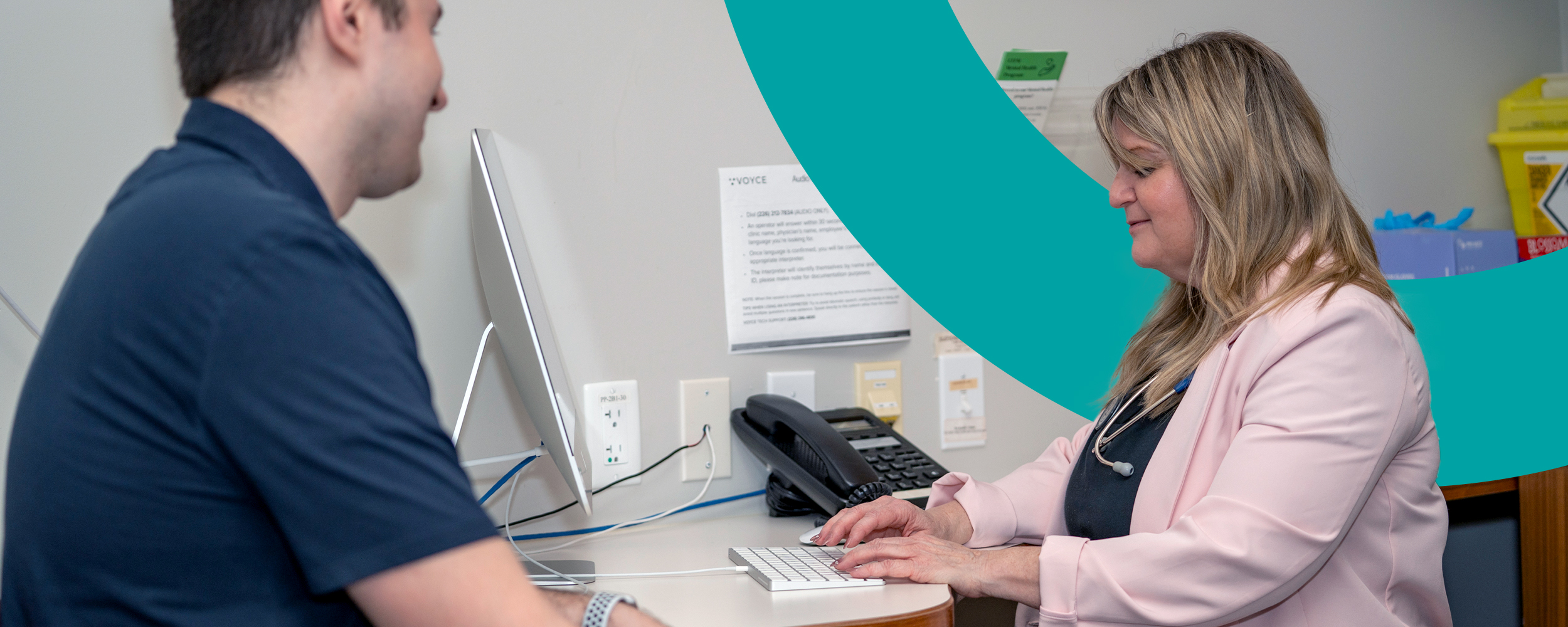A case study on the impact of the heart failure EMR tool in primary care
Heart failure is a chronic condition with a high risk of death. Once diagnosed with heart failure, 50% of people will die within five years, and over 90% within 10 years1. Yet, evidence-based best practice is not being delivered to patients consistently across Ontario1. Variations in care for patients with heart failure must be reduced to promote effective disease management.
Key takeaway
The Evidence2Practice Ontario (E2P) heart failure EMR tool supports clinicians in providing the optimal standard of care for patients with heart failure by bringing the most up-to-date evidence to the point of care.
E2P’s EMR-integrated point-of-care tools provide clinicians with access to the right evidence at the right time, allowing them to focus on caring for their patients while simultaneously ensuring their clinical practice is in alignment with best practice. E2P reduces the administrative burden associated with finding and updating this information on their own.
Impact in practice
Dr. R. Dacre, a primary care physician, shared his insights on the effectiveness and applicability of the E2P heart failure tool:
Improves time and resource efficiency, enabling clinicians to see more patients
Promotes holistic consideration of the patient to ensure appropriate care is provided
Helps identify patients who may benefit from hearth failure monitoring and disease management
Improves care towards best practices
This tool will help you ensure that you are up to date with the way that this disease is identified, diagnosed, treated, and monitored. It’s going to make you much more confident about how well you’re managing this patient – and not just more confident, but I think more pleased with how you’re doing it.
Dr. R. Dacre
Physician, Toronto, ON
Dr. R. Dacre is an independent physician in the Toronto region who accessed both change management support and academic detailing through the E2P program to support optimal use of the E2P heart failure tool. Since gaining access to the tool 7 months ago, Dr. Dacre has used the tool for all patients seen for their heart failure visits during this time. His practice treats a total of:

In this case study, 25% of patients over the age of 65 who had the tool used were prescribed the more recently recommended quadruple therapy medications, and 100% had received the recommended immunizations for patients with heart failure. Based on the findings of this case study, the sustained use of E2P tools at the point of care, at scale, has the potential to improve the management of patients with heart failure in Ontario.
Works Cited
- Ontario Health. “Heart Failure Care in the Community for Adults.” Quality Standards, 2019 [Online]. Available at: https://www.hqontario.ca/Portals/0/documents/evidence/quality-standards/qs-heart-failure-quality-standard-en.pdf
This case study is not to be reprinted without permission from the Evidence2Practice Ontario program.

Evidence2Practice Ontario (E2P) brings together multi-disciplinary, cross-sector expertise under the joint leadership of the Centre for Effective Practice, Amplify Care, and North York General Hospital. Funding and strategic guidance for E2P is provided by Ontario Health in support of Ontario’s Digital First for Health Strategy.

Interested in learning more?
Interested in partnering with us or learning more about
what we can offer you? Please reach out here.
Get the latest resources and insights
-

Plain Language Description: Ocean to Strata Integration
Amplify Care and Strata Health Solutions Inc. (Strata) are integrating their Ocean and Strata Pathways…
-

Agentic AI: The Missing Link Between Trust and Automation in Primary Care
Agentic AI systems are goal-directed, capable of autonomously planning and executing complex workflows in collaboration…
-

Cybersecurity in healthcare: how Shield’s training program can help protect your organization
Cybercriminals are increasingly targeting healthcare institutions for their sensitive data, and the consequences of a…
-

Online Appointment Booking: A case study on potential cost-savings from a Family Health Team perspective
Ontario Health has provided funding for the installation, onboarding, and licensing costs for healthcare practitioners…